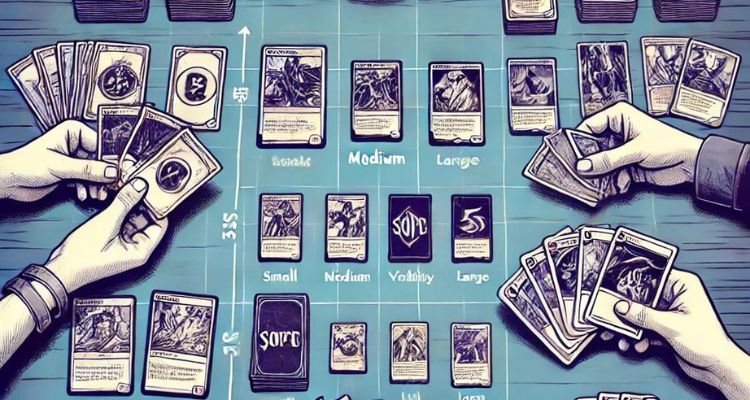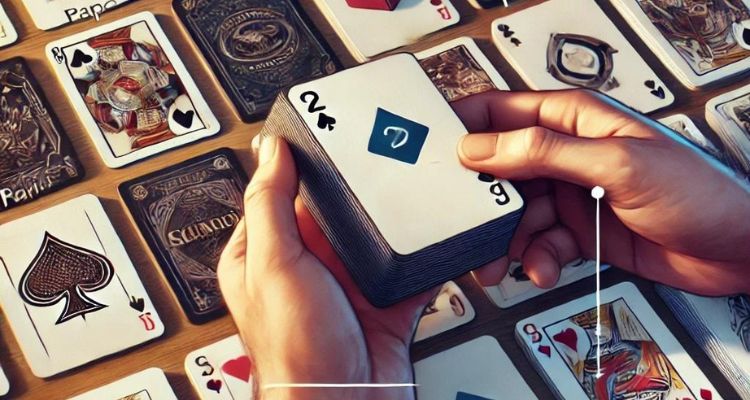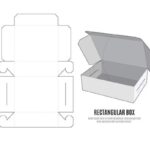Have you ever wondered why playing cards come in different sizes? It’s not just about aesthetics—playing card dimensions impact how you hold, shuffle, and interact with your cards. Whether you’re a game designer or an enthusiast, understanding the right card size can dramatically improve the user experience.
Let’s dive into the fascinating world of playing card sizes!
Standard Playing Card Sizes
Poker Size (2.5 x 3.5 inches)
The Poker Size card is the king of the deck. Measuring 2.5 x 3.5 inches, it’s the most widely used card size in casinos and home games. Think Poker, Blackjack, or any game where players need a versatile and easy-to-handle card.
- Perfect for shuffling and dealing.
- Great for games involving strategy or bluffing.
Fun fact: Casino professionals prefer poker-sized cards for their balance of grip and readability.
Bridge Size (2.25 x 3.5 inches)
Need something sleeker? Bridge Size cards are 2.25 x 3.5 inches and are ideal for games where you hold many cards at once, like Bridge or Rummy.
- Easier to hold due to their narrower width.
- Best for fast-paced games involving numerous cards.
Tarot Cards (2.75 x 4.75 inches)
Do you love a good mystery? Tarot Cards are larger, often 2.75 x 4.75 inches, and are used for tarot readings or specialty card games. The larger size allows for detailed artwork and symbols, which are essential in Tarot or role-playing games.
- Ideal for showcasing intricate designs.
- Easier to handle for laying out spreads.
Mini Cards (1.75 x 2.5 inches)
Compact, portable, and often adorable—Mini Cards are a fun alternative for travel games or as novelty items. With sizes around 1.75 x 2.5 inches, they’re perfect for short games on the go.
- Easy to store and carry.
- Used in travel games or promotional events.
Jumbo Cards (Oversized)
Want to make a big impression? Jumbo Cards are oversized and used mainly for promotional purposes or as novelties. They’re great for drawing attention, but not so much for practical gameplay!
Impact of Card Dimensions on Gameplay

Different card sizes don’t just affect aesthetics—they can change how a game is played. Here’s how:
- Ease of Handling: Larger cards are harder to shuffle but easier to see.
- Shuffling and Dealing: Smaller cards are easier to manipulate in fast-paced games.
- Readability: Larger cards make text and images easier to read, perfect for games where card detail is important.
So, which size suits your game? The answer depends on your gameplay style, audience, and design needs.
Read Also: Life-Size Barbie Box Dimensions | Your Complete Guide
Customizing Playing Card Dimensions
Factors to Consider When Customizing
When designing custom cards, size matters. Consider these points before finalizing your decision:
- Game Type: Will the cards need to fit comfortably in the player’s hands, or do they require a larger canvas for artwork?
- Handling: Think about how your players will shuffle and deal the cards.
- Storage: Larger cards require more storage space. Make sure your box design accommodates your card dimensions.
Printing Considerations
Size also impacts the printing process. For instance, larger cards may increase printing costs, especially if you want intricate artwork.
- Bleed and Safe Zones: Ensure your design accounts for printing margins to avoid cutting off essential artwork.
- Box Design: Don’t forget to design packaging that complements your custom card size.
Material Choices for Playing Cards
Paper Stock Options
Choosing the right material for your cards is crucial for durability and gameplay. Most cards are printed on paper stock, but there are other options:
- Paper: Standard playing cards are made from paper stock with different coatings for protection.
- Plastic: More durable and waterproof but can be more expensive.
Card Finishes and Coating
Protect your cards with the right finish:
- Glossy: Provides a shiny finish, making colors pop.
- Matte: Offers a smoother, more subtle look and feel.
- Laminated: Increases the durability of the cards, ideal for frequent use.
Read More: A Comprehensive Guide to Aqueous Coating in Printing
Corner Rounding
Don’t forget about the edges! Rounded corners are essential to prevent wear and tear over time.
- Rounded corners reduce damage.
- Enhance card durability for long-term use.
Card Durability and Ergonomics

Comparison of Durability Based on Size
How long will your cards last? That depends on both size and material. Larger cards may wear faster, especially if they’re handled roughly, while mini cards often last longer due to less handling pressure.
- Poker vs. Mini: Mini cards tend to be more durable because they face less stress during gameplay.
- Jumbo Cards: Great for promotional use but not ideal for extended gameplay due to wear.
Examples of Custom Playing Cards
Looking for inspiration? Here are some case studies of unique custom card designs:
| Game Name | Card Size | Usage |
| Exploding Kittens | 2.5 x 3.5 inches | Party game with simple, readable cards. |
| Cards Against Humanity | 2.75 x 4.75 inches | Large cards for easy reading. |
| Monopoly Deal | 2.25 x 3.5 inches | Fast-paced card game requiring quick moves. |
Conclusion: Choose the Right Size for Your Game
The right card size depends on your game design, audience, and usability requirements. Whether you’re creating a deck for poker night, a tarot reading, or a promotional event, 99 designs packaging helps you the right size will enhance game play and improve durability.





